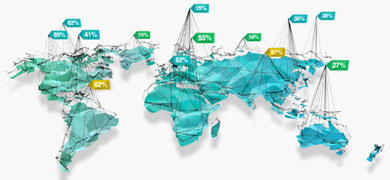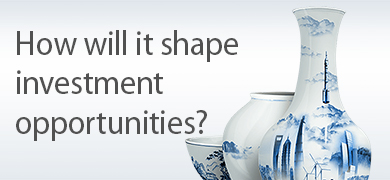Investment Insights
Asian stocks rose in October, with investors remaining focused on rising inflationary pressures and the US Federal Reserve’s tapering plans. The markets’ key concern is China’s economic performance and its impact on the energy and commodity complexes.
Balancing Act: Monthly insights from the Global Multi-Asset Team-November 2021
Has economic data really changed so much as to suggest an inflection point on inflation and the growth outlook was near? To some degree perhaps, at least in the eyes of the market, but not enough in the end for central banks to meaningfully change their guidance.
On the ground in Asia: Monthly insights from the Asian Fixed Income Team-October 2021
We expect Indonesian bonds to outperform, as demand is supported by positive supply technicals. Meanwhile, we see bonds of low-yielding countries like Singapore, South Korea and Thailand prone to bear flattening, driven mainly by UST movement.
New Zealand Fixed Income Monthly - October 2021
October was a tough month for the New Zealand bond market with yields rising in anticipation of further increases in cash rates and in response to global markets bracing for the possibility of central banks reducing stimulus by tapering bond purchases.
Global Fixed Income Quarterly - Q4 2021 Outlook
The optimist says prices are cheap. The pessimist says prices are expensive. The central banker says inflation is transitory. We remain in the aftermath of a month where the worldview on the future of monetary policy has dramatically changed.
New Zealand Equity Monthly – October 2021
The New Zealand stock market has been flat in the calendar year to date, with companies working to adapt to a number of risk factors. This puts it in stark contrast with markets in the rest of the developed world, which have seen gains ranging from 10% to 25%.
Japan Value Insights: Medical technology key to value and addressing inefficiencies
Japan’s rapidly advancing medical technology is viewed as a way to address the healthcare sector’s inefficiencies while at the same time offering potential value opportunities.
Japan Equity Monthly – October 2021
We explain how the recent lower house election win gives Japan’s new prime minister a free hand to pursue policies aimed to help the economy recover from COVID-19. We also analyse why a weaker yen no longer provides as much of a boost to equities.
Global Equity Quarterly Q3 2021
Our philosophy is centred on the search for “Future Quality” in a company. Future Quality companies are those that we believe will attain and sustain high returns on investment. ESG considerations are integral to Future Quality investing as good companies make for good investment
Asian Fixed Income Monthly - September 2021
US Treasury (UST) yields rose in September, with the US Federal Open Market Committee finally alluding to moderate its asset purchases as soon as November. The rise in rates was further supported by an escalating power crunch across Europe and China amid surging energy prices prompting concerns about inflation.
Multi-asset Monthly - October 2021
Volatility has arisen as we expected it eventually would, and September is often an apt month to rediscover risk given market participants’ return from summer vacations noting that record high equity markets do not quite square with a number of significant risk events on the near-term horizon.
Asian Equity Monthly - September 2021
Asian stocks fell in September, with concerns about China’s growth outlook and the US Federal Reserve (Fed)’s taper plan being the key drivers of sentiment. For the month, the MSCI AC Asia ex Japan Index declined by 4.2% in US dollar (USD) terms.
New Zealand Equity Monthly – September 2021
The equity market reaction to New Zealand’s second COVID-19 lockdown has been far more muted than the first time similar restrictions were imposed. The first lockdown from March 2020 caused an aggressive sell-off as investors and companies alike adjusted to a completely unprecedented situation.
Japan Equity Monthly - September 2021
We provide an update of Japan’s political calendar as the new Prime Minister Kishida leads the ruling party into a 31 October general election, which could have a significant market impact. We also discuss what the recent China-related volatility could mean for the Japanese market.
New Zealand Fixed Income Monthly - September 2021
Since the Reserve Bank of New Zealand (RBNZ) postponed a widely expected rate hike in August, pricing in the market has pulled back, supporting a view that the central bank will hike rates by 25 basis points (bps) at each of its next three policy meetings.
What can investors expect from a Kishida government?
As expected by most observers, Mr. Kishida won the Liberal Democratic Party presidential election in the second round with a sturdy, though not overwhelming, 60% of the vote. He will be formally named prime minister next week and will likely form a relatively youthful cabinet, with females in several major posts.
Global Investment Committee’s 12-month Outlook: Continue risk-positive, especially for Japan
Out of the six scenarios presented, a narrow majority of our committee agreed again on a positive scenario in which the global economy matches the market consensus for solid growth, while equities continue to rally.
The past five years have been the hottest since records began. In the decade to 2020, global surface temperatures were 1.09C higher compared to the pre-industrial era (1850–1900)1. The Intergovernmental Panel on Climate Change (IPCC) warns that stabilising global warming below the 1.5C level is critical to avoiding the most extreme impacts on ecosystems and human health.
Latin America: Supplier to a commodity-hungry world
Inflation is on everyone’s mind. From central bankers to bakers, it is one of the biggest topics of discussion. The prices of many commodities are rising sharply. The reasons vary. Supply constraints, sharp rise in demand or bad weather—take your pick.
Multi-asset Monthly - September 2021
As we contemplate a post-pandemic world, it is becoming more likely that things will not return to “normal” as we once knew it. While vaccines have been highly successful in preventing serious illness in those who are still contracting the virus, the Delta variant of COVID-19 is also proving to be harder to contain.

























